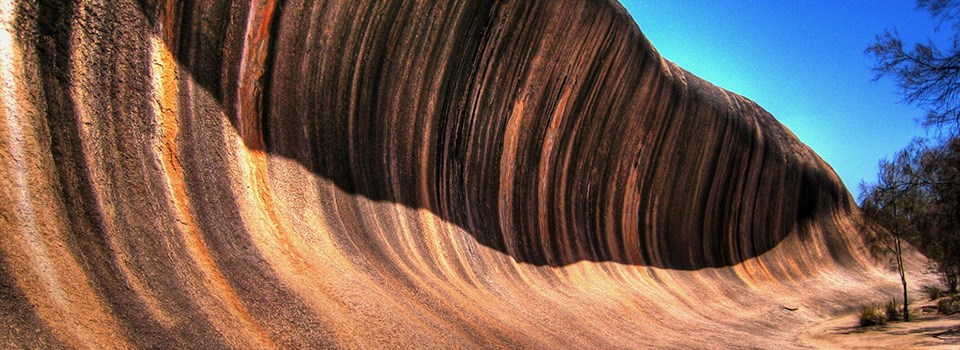Hyden, a small town hidden away in WA’s massive Wheat Belt, is home to the famous Wave Rock on the north face of a large outcrop called Hyden Rock. It’s a surprisingly pleasant place, a long way from nowhere.
Hyden is a small, isolated agricultural town with a population of about 200 in the east of WA’s Wheat Belt. It is 339km east of Perth, about 160km south-east of Merredin, about 310km west of Norseman (mainly across dirt roads) and 382km north-west of Esperance.
Hyden’s principal claim to fame is the iconic Wave Rock, 4km east of the town site. But there is much more than the rock to make it well worth the lengthy diversion.



JUNK ART
We chose to drive from Secret Harbour south of Rockingham east through Pinjarra, Dwellingup, Quindanning, Williams, Narrogin and Kondinin. That took us through the jarrah forest of the Darling Range before we emerged at Quindanning onto the undulating, seemingly endless, grain-growing country rolling eastward to Hyden. Vast expanses of grain crops are broken up by patches of uncleared mallee, hardwood forest interspersed with small towns and huge granite outcrops. The roads are sealed and generally in very good condition. There are plenty of rest areas to pull off the road for a brew and a closer look at the flora. In the spring this entire area is ablaze with colour, not only of crops approaching harvest but also of the prolific wildflowers of WA.
Arriving in Hyden we were struck by the large parking area in the town centre, quite suitable for caravans. Between the road and the parking area is an amazing collection of ‘junk’ art – the town’s Heritage Walk which tells much of the history of the town. In the words of one energetic resident, “We don’t ask why ‘they’ can’t do something. We are ‘they’.” These people do things themselves, from building the local airstrip to developing the caravan park and adjacent resort, the motel and the roadhouse, which were all built by the locally owned Hyden Tourist Development Company.
THE ACTUAL ROCK
Four kilometres east, Wave Rock stands masked by surrounding mallee forest. At the entrance to the rock reserve is a sheltered information display detailing much of the history of the district, the rock and its geology. It also gives a good introduction to the local flora and fauna. A gravel path leads to the famous rock face through mallee trees and dense undergrowth. Even in mid-November this was ablaze with masses of native flowers. There are numerous small plaques identifying shrubs and trees.
The path arrives at the eastern end of the wave portion of the rock, with a spectacular view through the 110m-long ‘tube’. This section of rock is not enormous but does stand about 15m high and displays the classic wave form and vertical, coloured stripes. Depending on the information source, these stripes are the result of algae proliferating on the surface when wet, or by deposition of dissolved salts when the wet surfaces dry out. Either way, they add spectacular colour to the wave surface, especially when the sun is low in the sky on either side. The rock is estimated to be 2.7 billion years old.
There are a series of informative signs in small shelters along the length of the wave. The rock is a catchment for the town’s water supply, with a foot-high concrete/stone wall along the top directing water to the reservoir further westward, where there’s an information plaque giving its history and a steel stairway leading up onto the rock itself.
It is an easy climb up the staircase and worth the effort for the spectacular view of the surrounding countryside. The views are marred a little by the fence around the reservoir and the concrete water diversion barriers, but they are part of the history.
To the north, the rock is fringed by she-oak trees between it and the caravan park. Then a strip of mallee forest is followed by extensive swamp lands and Lake Magic and, finally, the rolling grain fields stretch into the distance where a small mountain stands up from the plains.
The surface of the rock is chipped and pitted by the ageing process, and in places large thin sheets of rock have detached and slid down into piles at low points. Moss and lichens abound in different colours. There are numerous depressions, some containing enough soil to support grasses and small shrubs. Some contained water when we visited shortly after rains. A copse of trees grow in each of two large hollows in the centre of the rock. Numerous small birds flutter about the place and there are reptiles including various lizards and the occasional rock python.
OTHER SITES
Early morning is an ideal time to explore the 3.5km Wave Rock Walk Circuit on foot or by bicycle. It is practically flat and okay for prams and wheelchairs. Along the way you pass Hippo’s Yawn, a rock eroded into the shape of a huge yawning hippo. Interpretive panels provide information on all aspects of the area from indigenous history to the night sky, birds and local history.
Information is available on other nearby attractions accessible by car, such as Mulka’s Cave 20km to the north, which has some of the best Aboriginal art in South-West WA. When you have done all that, you will have come to the realisation that a visit to Wave Rock is much, much more than just “…have a look at the rock and keep going.”





